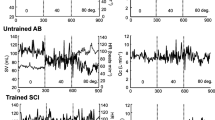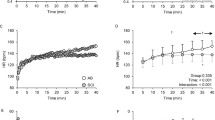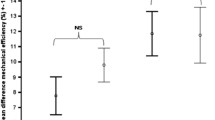Abstract
The number of patients that suffer some type of spinal cord lesion in recent years are high and have increased because of factors such as traffic accidents. Although their life expectancy has increased, cardiovascular illnesses is one of the main causes of morbidity and mortality. Since the degree of physical fitness is an important factor regarding the risk of cardiovascular disease, the objective of the present study was to examine the global adaptation (cardiorespiratory, metabolic and thermoregulatory response) of the organism to exercise and the application of this data to the habitual practice of physical activity to improve state of health. A group of 42 patients with spinal injury, 85% of whom were paraplegic and the remaining 15% tetraplegic performed 42 exercise tests on a cycloergometer. Body temperature (tympanum, surface of the deltoids and surface of the back), metabolic parameters (plasma uric acid, glycemia, plasma lactate), cardiocirculatory adaptation (heart rate, blood pressure arm, blood pressure leg) and ventilatory adaptation (VO2, VCO2, fr Vt, VE) were monitored. Blood pressure in the arm, blood concentrations of lactate and ventilatory parameters showed an evolution statistically dependent on the work to which the subject was submitted. Heart rate showed a statistically significant correlation with the ventilatory parameters and work load. The proportional response of the cardioventilatory parameters to the increase in the work load allowed us to evaluate the repercussion of a given exercise and thus avoid exercise of an excessive intensity that could produce cardiocirculatory changes that might entail an added risk. Heart rate presents an excellent correlation, shown in this work, with the oxygen consumption and could therefore be used to quantify the cardiorespiratory and metabolic repercussion of the exercise carried out. Furthermore, this quantification may allow for the adaptation of exercise intensity to the patient thus improving the results obtained from the practice of exercise that has been proven so necessary in these patients.
La lesión medular es una dramática situación que, en general, ocurre tras un accidente de tráfico. La esperanza de vida en estos pacientes ha aumentado en los últimos años, siendo en la actualidad las enfermedades cardiovasculares una de las causas principales de morbimortalidad. El objetivo del presente estudio consiste en conocer la adaptación (respuesta cardiorrespiratoria, metabólica y de termorregulación) del organismo al ejercicio y su posible aplicación a la práctica habitual de actividad física para mejorar su estado de salud.
Un grupo de 42 lesionados medulares, el 85% parapléjicos y el 15% tetrapléjicos, realizaron una prueba de esfuerzo con brazos en cicloergómetro. Se monitorizó la temperatura en diferentes lugares (timpánica, cutánea en la región deltoidea, cutánea en la región escapular), los parámetros metabólicos (ácido úrico, glucemia, lactato sanguíneo), la adaptación cardiocirculatoria (frecuencia cardíaca, presión arterial en brazo y pierna) y la ventilatoria (VO2, VCO2, fr, Vt, VE).
La presión arterial en el brazo aumenta significativamente al aumentar la carga. La frecuencia cardíaca presenta un aumento estadísticamente significativo dependiente del aumento del trabajo. Se observa un aumento estadísticamente significativo en la concentración de lactato sanguíneo al aumentar la carga. Los parámetros ventilatorios muestran una evolución que es estadísticamente dependiente de la carga a la que son sometidos los sujetos. La frecuencia cardíaca refleja una correlación estadísticamente significativa con los parámetros ventilatorios y la carga de trabajo.
La respuesta proporcional de los parámetros cardioventilatorios al aumento de la carga permite evaluar la repercusión de un ejercicio, evitando una intensidad excesiva que produzca cambios cardiocirculatorios que podrían traer consigo un riesgo añadido. La frecuencia cardíaca presenta una excelente correlación, en el grupo estudiado, con el consumo de oxígeno, pudiendo ser una variable que permita el seguimiento de la repercusión cardiorrespiratoria y metabólica de la carga a la que es sometido el paciente. Además, permitirá adaptar el nivel de actividad física al sujeto, mejorando los resultados obtenidos por la práctica de ejercicio en estos pacientes.
Similar content being viewed by others
References
Arrowood, J.A., Mohant, P.K. and Thames, M.D. (1987):Phys. Med. Rehabil. State. Art. Rev.,1, 443–456.
Barstow, T.J., Scremin, A.M.E., Mutton, D.L., Kunkel, C.F., Cagle, T.G. and Whipp, B.J. (2000):Spinal Cord.,38, 340–345.
Corbett, J.L., Debarge, O., Frankel, H.L. and Mathias, C.J. (1975):Clin. Exp. Pharm. Physiol.,2, 189–193.
Dallmeijer, A.J., Van der Winde, L.H.V., Hollander, A.P. and Van As, H.H.J. (1999):Med. Sci. Sports. Exerc.,31, 1330–1335.
Davids, G. M. (1993):Med. Sci. Sports. Exerc.,25, 423–432.
Davies, C.T.M., Few, J., Foster, K.G. and Sargeant, A.J. (1974):Eur. J. Appl. Physiol.,32, 195–206.
Ditunno, J.F., Jr, Young, W., Donovan, W.H. and Creasey, G. (1994):Paraplegia,32, 70–80.
Erikkssen, J. (1982):Acta Med. Scand.,711, 189–192.
Frey, G.C., McCubbin, J.A., Dunn, J.M. and Mazzeo, R. S. (1997):Med. Sci. Sports. Exerc.,29, 451–456.
Gisolfi, C.V. and Wenger, C.B. (1984): In “Exercise and Sport Sciences Reviews”. (Terjung, R.L., Ed.). Collamore Press, Lexington. pp. 339–372.
Hartkopp, A., Bronnum-Hansen, H., Seidenscnur, A.M. and Biering-Sorensen, F. (1997):Spinal Cord.,35, 76–85.
Hellsten-Westing, Y., Sollevi, A. and Sjodin, B. (1991):Eur. J. Appl. Physiol.,62, 380–384.
Hopman, M.T.E. (1994):Int. J. Sports Med.,15, 563–566.
Huouker, M., Schmid, A., Svrichter, S., Schmidt-Trucksäb, Mrosek, P. and Keul, J. (1998):Med. Sci. Sport Exer.,30, 609–613.
Keyser, R.E., Rodgers, M.M., Gardner, E.R. and Russell, P.J. (1999):Arch. Phys. Med. Rehab.,80, 1288–1292.
Midha, M., Schmitt, J.K. and Sclater, M. (1999):Arch. Phys. Med. Rehab.,80, 258–261.
Midha, M., Schmitt, J.K. and Sclater, M. (1999):Arch. Phys. Med. Rehab.,80, 258–261.
Nielsen, B. and Nielsen, M. (1962):Acta Physiol. Scand.,56, 120–129.
Normell, L.A. (1974):Scand. J. Clin. Lab. Invest.,138, 25–41.
Pollock, M. and Wilmore, J. (1990): “Exercise in Health and Disease”. W. B. Saunders, Sydney.
Price, D.T., Davidoff, R. and Balady, G.J. (2000):Am. J. Cardiol.,85, 996–1001.
Price, M. J. and Campbell, I. G. (1999):Int. J. Sports Med.,20, 457–463.
Price, M.J. and Campbell, I.G. (1999):Spinal Cord,37, 772–779.
Rodríguez-Jerez, A. (1992): In “Fisiología de la Actividad Física y del Deporte”. (González Gallego, J.). Ed. Interamericana McGraw Hill, Madrid. pp. 190–191.
Sawka, M.N. (1986): In “Exercise and Sport Sciences Reviews” (Pandolf, K. B., Ed.). Macmillan, New York. pp. 175–211.
Schantz, P., Sjöberg, B., Widebeck, A.M. and Ekblom, B. (1997):Acta Physiol. Scand.,161, 31–39.
Spirduso, W.W. and Cronin, D.L. (2001):Med. Sci. Sports Exer.,33, 598–608.
Tam, H.S., Darling, R.C., Cheh, H.Y. and Downey, J.A. (1978):J. Appl. Physiol.,45, 451–458.
Vinet, A., LeGallais, D., Bernad, P.L., Poulain, M., Varray, A., Mercier, J. and Micallef, J.P. (1977):Eur. J. Appl. Physiol.,76, 455–461.
Yekutiel, M., Brooks, M.E., Ohry, A., Yarom, J. and Carel, R. (1989):Paraplegia,27, 58–62.
Washburn, R.A. and Figoni, S. F. (1999):Spinal Cord,685–695.
Wilmore, J.H. and Costill, D.L. (2001). “Fisiología del esfuerzo y del deporte”. Ed. Paidotribo, Barcelona.
Author information
Authors and Affiliations
Rights and permissions
About this article
Cite this article
Vidal, J., Javierre, C., Segura, R. et al. Physiological adaptations to exercise in people with spinal cord injury. J. Physiol. Biochem. 59, 11–18 (2003). https://doi.org/10.1007/BF03179863
Received:
Issue Date:
DOI: https://doi.org/10.1007/BF03179863




